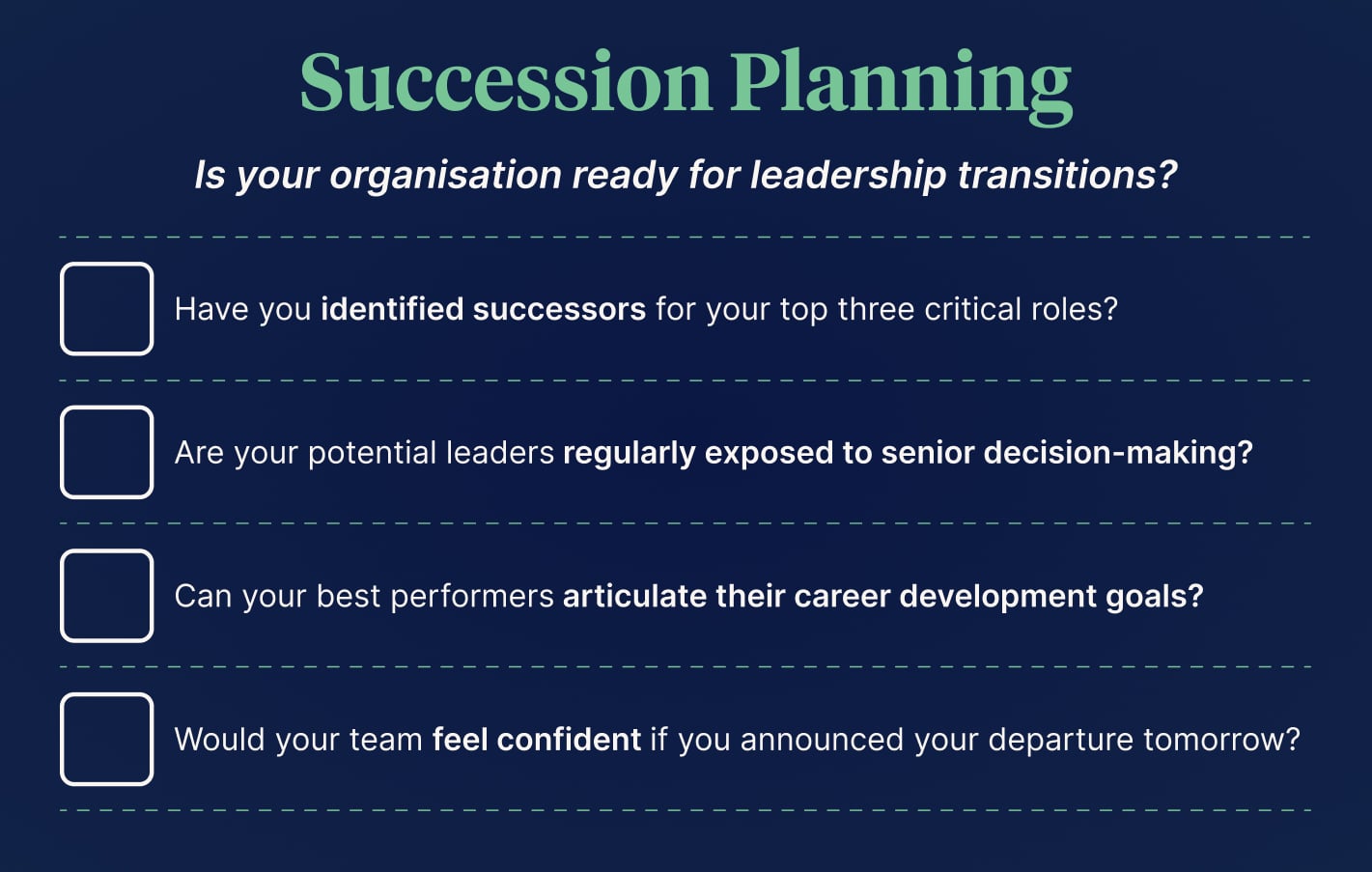Why Succession Planning Is the Hidden Power Source of Sustainable Leadership
It’s Monday morning, and once again you’re back on the phone to HR, crafting job advertisements for yet another round of resignations. One’s off on maternity leave, one’s retiring, and the other’s relocating. Your nurses are asking who's in charge. Your executive team is scrambling. Your residents and clients are sensing the uncertainty. Sound familiar? In Australia’s aged care sector, where the average staff turnover rate hovers around 29% this kind of churn can feel like Groundhog Day.
This scenario sets off panic buttons in any healthcare organisation, but it doesn't have to. While only 7% of organisations overall feel prepared for leadership transitions, the challenge is even more pronounced in healthcare, where 57% lack formal succession plans entirely [1,2]. Here's what separates thriving facilities from those in crisis: they've built their 'spare battery' long before they needed it.
The reality is that there comes a time when we all transition out of our roles. Whether by retirement, burnout, or new opportunities, leadership change is inevitable. The real question is, when your time comes, who’s ready to take your place?
When I left my most recent role, I wasn’t anxious. Why? Because I had invested in developing someone who could seamlessly step in, lead confidently, and carry the torch forward. From the day I hired them, I made their development part of my daily leadership practice. The result? A smooth transition, a confident successor, and a business unit that continued with uninterrupted service.
The hidden cost of poor succession planning
But when there’s no plan in place, the cracks show quickly, and the consequences can be far-reaching. Recruitment firms and head-hunters can offer a quick fix, but at what cost? Besides the obvious financial outlay, hiring the wrong person can drain morale and set progress back by months. Worse still, it signals to the team that leadership choices are made without transparency, leaving capable staff feeling overlooked, disengaged and disillusioned.
To compound the issue, the most damaging misstep is promoting technically competent staff who haven’t been prepared for people leadership. These individuals may be experts in their field but, without coaching and experience in leading teams, they often flounder. This is where nearly half of all leadership transitions fail [3].
Why Succession Planning Matters
Despite its importance, succession planning is often seen as a luxury, not a necessity.
But when key leaders leave without preparation, it creates a leadership vacuum, and creates what Ram Charan calls "the leadership pipeline clog." The scramble that follows isn't just costly, it's chaotic and damaging. [4]
In aged care, where leadership turnover, workforce ageing, and nursing shortages are critical issues, we cannot afford to ignore succession planning. Promoting internal staff into leadership roles not only strengthens clinical outcomes but also builds a reliable internal talent pipeline. The win-win? Those who move through the leadership pipeline are more likely to do the same for those coming up behind them.
So, if you stepped away tomorrow, who would carry your role forward, without disruption, doubt, or detour?
Many organisations still rely on expensive consultants, rushed recruitment, or poorly prepared internal candidates to fill critical roles. The outcome? Poor hires, disrupted teams, and missed opportunities.
Succession planning is not just a leadership initiative; it’s a critical risk management strategy, especially in aged care, where regulatory, financial, and clinical risks are tightly interwoven with leadership stability.
Quick Assessment: Is Your Organisation Ready?
- Have you identified successors for your top 3 critical roles?
- Are your potential leaders regularly exposed to senior decision-making?
- Can your best performers articulate their career development goals?
- Would your team feel confident if you announced your departure tomorrow?
If you answered ‘no’ to any of these questions, it’s time to act.

Building a Culture of Readiness
Great leaders aren’t just remembered for their results; they’re remembered for the people they nurtured along the way. They build great successors. It is a proud moment for any leader to see their staff succeed, but it requires intentional action.
Succession planning isn’t just about filling a vacancy; it’s about creating a sustainable culture of continuous growth and readiness. It lays the foundation for creating a learning and leadership culture. A healthy leadership pipeline means investing across all levels and in every individual to build capability from the ground up [1]. Staff on the frontline have a deep understanding of the issues and often hold answers that never reach the executive boardroom. It means identifying emerging leaders early, supporting them consistently, and exposing them to the realities of leadership long before a role becomes vacant.
Leaders who do this well act like talent scouts, always scanning for skill, will, and potential. They coach and develop their teams daily, recognising that everyone brings a unique set of strengths and that ‘potential’ isn’t fixed, it’s cultivated. In doing so, it develops a workforce that feels seen, supported, and inspired. They become highly engaged, committed employees who know that they matter and see a meaningful future with the organisation.
Ingredients of Effective Succession Planning
Research shows that 70% of succession plans fail within two years. According to Development Dimensions International (DDI), Global Leadership Forecast [5], this is because executives treat it as a compliance or HR exercise rather than a core leadership responsibility. To succeed, three conditions must exist:
- A Culture of Leadership Development: Buy-in from senior leadership is non-negotiable. Leaders must walk the talk—coaching, mentoring, and modelling leadership behaviours.
- Clear Identification of Critical Roles: Know which positions are mission critical. If left vacant, they could derail projects, damage culture, or delay essential services [6,7].
- Partner with Experts to Build a Strategic Succession Plan: Your HR and L&D teams are key partners in identifying high-potential talent, crafting tailored development plans, and embedding succession planning practices into everyday operations. Engage them early and often to ensure your approach is aligned, strategic, and sustainable.
Practical Strategies that Support Succession Plans
| Schedule weekly development conversations | Move beyond status updates to focus on growth, challenges, and career aspirations during dedicated one-on-one time |
| Create clear career roadmaps together | Map out specific milestones for short-term wins (6 months), medium-term growth (1-2 years), and long-term leadership goals (3-5 years) |
| Design personalised learning journeys | Build development plans that align individual strengths with organisational needs, not generic training programs |
| Connect them to your networks | Provide access to learning management systems, professional forums, industry events, and leadership communities that expand their perspective |
| Establish feedback loops that accelerate growth | Create regular, two-way conversations focused on development, not just performance evaluation |
| Give them the keys during your leave of absence | Offer acting opportunities during leave periods and ensure support is available |
| Delegate meaningful stretch assignments | Assign projects that challenge their current capabilities and expose them to cross-functional decision-making |
| Pair them with external mentors | Connect them with senior leaders outside their direct reporting line for unbiased guidance and broader perspectives |
| Invite them behind the leadership curtain | Include promising team members in strategic planning sessions, executive meetings, and senior decision-making forums |
| Make leadership development measurable | Integrate leadership capabilities, influence, and team impact into formal performance discussions and career progression criteria |
| Track their growth story | Ask direct reports to update their resume every six months, highlighting new achievements, skills, and contributions. This builds confidence and documents their leadership journey |
These practices aren't time-consuming initiatives; they're deliberate, proven leadership habits that generate business value through creating sustainable succession plans and talent pipelines.
Common Challenges (and How to Avoid Them)
- Lack of Executive Buy-In: Without top-level commitment, succession planning stalls or fails. To avoid this, engage senior leaders early by clearly linking succession planning to organisational performance, risk mitigation, and strategic continuity. Make leadership development a key performance indicator.
- Fear of Change: Succession planning can trigger insecurity. Open communication and transparency on the process is key. Frame it as a growth opportunity, not replacement planning.
- Limited Resources: Time, budget, and focus are all challenges. But succession planning is a strategic investment, not an expense. Calculate the true cost of poor leadership transitions.
- Poor Data: Succession decisions should be guided by real data from performance management, engagement surveys, 360° feedback, and future workforce needs analysis. Challenge assumptions and biases.
Investing in Tomorrow’s Leaders, Today
Succession planning increases retention, capability, and care quality. In aged care, where stability and culture directly impact outcomes, the absence of a plan isn’t just a business risk; it’s also a clinical risk.
Leadership isn’t just about holding the torch, it’s about passing it on. The organisations that thrive tomorrow are investing in their people today.
So, as you reflect on your team today, ask yourself: Who is my spare battery? Who are you developing, coaching, and trusting to lead when it’s your time to step aside?
Your future self, your team, and the people you serve will thank you for the investment you make in developing tomorrow’s leaders today.



